
11/06/08 4B
We started work energy and power.
When stuff happens, energy is converted from one form to another. The total amount of energy in the universe has been constant since the start of time, it cannot be created or destroyed.
Types:
Kinetic (due to movement)
Potential (gravitational, electrostatic, magnetic, nuclear, chemical, elastic)
Light (electromagnetic)
Sound
Electrical 09/06/08 4B
We went through the exam.... Grade boundaries tba.
No me (AS practical exam). You did some GCSE aand iGCSE questions on waves for me.
Test on waves as promised.
So I have finally lost track of the linear nature of time. I hadn't missed a post for 4B at all, just 4P. We covered the dangers of electromagnetic radiation today during the first part of the lesson as detailed below.
We then moved onto revision of the waves part of the syllabus which we have now finished.
HW You did some GCSE questions which you should probably finish for revision for a waves test which will be next lesson. We'll move to more general revision after that.
A missing post for both classes! This indicates RM may be running out of steam.....
However, we studied specifically the dangers of the different types of electromagnetic radiation.
The energy, danger and frequency of electromagnetic waves
The danger of a wave increases as its energy and frequency increase.
| Wave | source | Effects |
| microwaves | mobile phones | can warm brain tissue caution needed |
| ultraviolet | sunbathing | causes changes in skin cells causing cancer |
| X-rays | medical | risk of change to cells in body causing cancer |
| gamma rays | radiation from space or rocks | high risk of cancer cell developing |
The effects of electromagnetic waves on the body
All electromagnetic waves can heat the body. The more energy the
bigger the effect. Larger amounts of energy can cause burning.
Ultra violet, X-rays and gamma rays can damage cells in
the body. Ultraviolet can damage the eyes.
If they damage the nucleus of the cell then it may grow out of control and form
a cancer. If the cells damaged are sperm or egg cells then the damage is
passed on to the next generation.
Higher frequency electromagnetic radiation is inherently more dangerous as it carries more energy with it. The particle model of light helps to explain this but is beyond iGCSE...
HW I only have a very few copies of the em waves calculations sheet , this must be handed in asap.
All electromagnetic waves travel at the speed of light (300000000m/s) and can travel through a vacuum.

All objects which have a temperature above absolute zero will emit some form of electromagnetic radiation. The higher the temperature, the smaller the wavelength that is emitted.
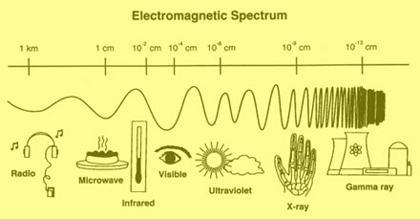
You are required to know the names, rough wavelengths, uses and dangers for each of the main areas of the spectrum.
If you missed the lesson I suggest that you read this or this (dubious nmenomics) website, or look at the table below from BBC bitesize.
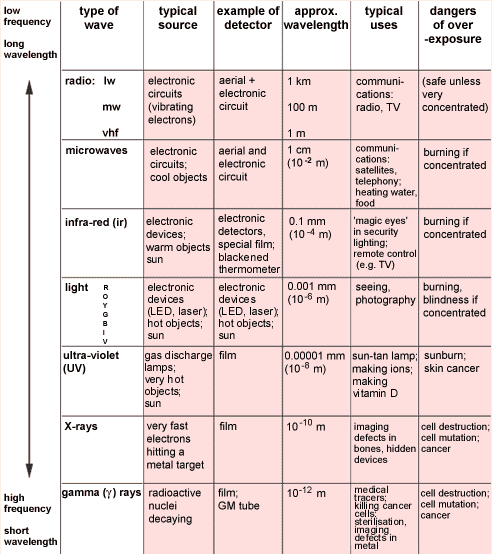
You did some bits of work One qualitative , and the other quantitative. About e-m waves.
HW Finish the 2nd worksheet up to the end of Q7.
We continued to study electromagnetic waves. You have completed some bits of work One qualitative , and the other quantitative. About e-m waves.
HW Finish the 2nd worksheet up to the end of Q7 if not done in the lesson. I'll collect both sheets next lesson.
Some orchestral types were missing but we plowed on with the electromagnetic spectrum anyhow.
Electromagnetic waves require no matter as a medium because they are vibrations in electric and magnetic fields. They are transverse waves, with the electric field and magnetic field vibrating at right angles to each other.
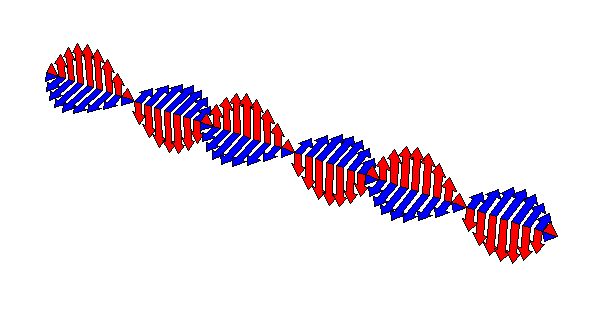
The above animation is wrong, the magnetic and electric fields should vibrate 90 degrees out of phase.
All electromagnetic waves travel at the speed of light (300000000m/s) and can travel through a vacuum.

All objects which have a temperature above absolute zero will emit some form of electromagnetic radiation. The higher the temperature, the smaller the wavelength that is emitted.

You are required to know the names, rough wavelengths, uses and dangers for each of the main areas of the spectrum.
If you missed the lesson I suggest that you read this or this (dubious nmenomics) website, or look at the table below from BBC bitesize.

HW Finish set of questions on electromagnetic waves.
Analogue and digital signals was finished off.
The key point is:
Analogue signals are continuosly variable. Digital signals only take certain discrete values.
Any analogue signal can be sampled and converted into a digital one.
Digital signals can be converted into binary code for transmission over long distances. This makes it vastly less likely that the content of the signal will be misunderstood at the receiving end due to interference or attenuation (the signal getting weaker).
In an analogue signal, any interference will be made worse every time the signal is amplified and re-transmitted (the mistakes in the signal are made bigger too.) For a digital signal, a perfect copy is re-transmitted every time.

We then just started to look at the electromagnetic spectrum. More on this next time.
Electromagnetic waves require no matter as a medium because they are vibrations in electric and magnetic fields. They are transverse waves, with the electric field and magnetic field vibrating at right angles to each other.

The above animation is wrong, the magnetic and electric fields should vibrate 90 degrees out of phase.
All electromagnetic waves travel at the speed of light (300000000m/s) and can travel through a vacuum.
HW Various people owe me both the refraction GCSE Qs sheet and IGCSE text book P98/99 Qs 4, 6, 8 which must be handed in asap.
We recapped the law of reflection in plane mirrors.
Position of an image in a plane mirror and curved mirrors.
A flat mirror creates an image which appears to be behind the mirror (the same distance that the object is in front.)

Mirror images are virtual, and always left to right inverted.
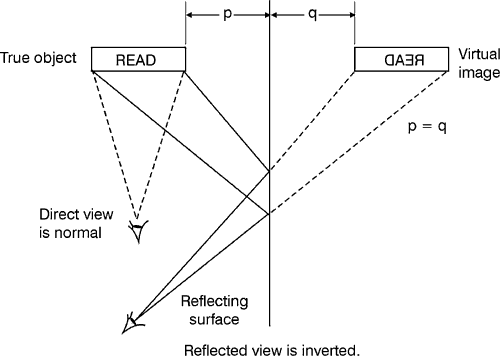
Then onto optical fibres and analogue and digital.
Advantages of optical fibres over electrical wires are:
There are a couple of disadvantages: It is hard to join (splice) optical fibres together accurately. Also, the very careful manufacturing process required for optical fibres means they need high technology and expensive factories to make them.
We also discussed the difference between an analogue and a digital signal. Which is entirely seperate to the difference between the comparisons af sending light down an electric cable or an optical fibre.

An analogue signal is an exact copy of a signal (such as a sound wave). A digital signal records the level of the original signal many times a second and so the information can be sent as a series of numbers.
The series of numbers is usually turned into binary code which means it is turned into base 2. The only possible numbers in base 2 are 1 or zero.
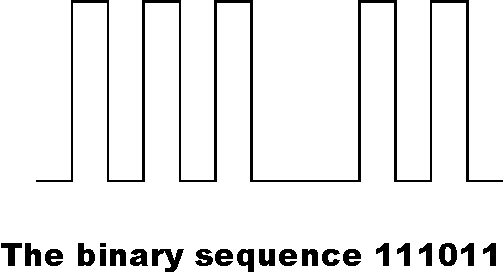
It is much easier to retain the quality of a signal if it is sent in binary code. Any interference does not usually stop the ability of the reciever to tell the difference between a 1 or 0.
HW Qs 4,6,8 P98/99
We recapped the law of reflection in plane mirrors.
href="http://www.glenbrook.k12.il.us/gbssci/phys/Class/refln/u13l2b.html">Position of an image in a plane mirror and curved mirrors.
A flat mirror creates an image which appears to be behind the mirror (the same distance that the object is in front.)

Mirror images are virtual, and always left to right inverted.

HW Q3 P107 (aswell as Qs 5, 7 for next time.)
More Snell's law then onto optical fibres and analogue and digital.
Advantages of optical fibres over electrical wires are:
There are a couple of disadvantages: It is hard to join (splice) optical fibres together accurately. Also, the very careful manufacturing process required for optical fibres means they need high technology and expensive factories to make them.
We also discussed the difference between an analogue and a digital signal. Which is entirely seperate to the difference between the comparisons af sending light down an electric cable or an optical fibre.

An analogue signal is an exact copy of a signal (such as a sound wave). A digital signal records the level of the original signal many times a second and so the information can be sent as a series of numbers.
The series of numbers is usually turned into binary code which means it is turned into base 2. The only possible numbers in base 2 are 1 or zero.

It is much easier to retain the quality of a signal if it is sent in binary code. Any interference does not usually stop the ability of the reciever to tell the difference between a 1 or 0.
HW P98-99 Qs 5 and 7. You'll have to read the chapter on these 2.
We looked at calculations involving the simplified version of Snells law that you are required to know for IGCSE. This set of calculations was attempted.
We also looked at an adaptation of the equation for the specific case when light is shining out of a more optically dense material at its critical angle.
The critical angle is the angle of incidence at which total internal reflection first occurs.
This set of calculations was attempted.
We redid the 2 experiments on refraction that you probably did in the 3rd form. Both experiments showed Snell's law in action.
An experiment was carried out to see how much rays of light bent when they passed into a glass or perspex block. Rays were found to always bend towards the normal line (90 degrees from the glass surface) when they entered the block. This bending is called refraction. It happens because the light changes speed as it enters the perspex block.
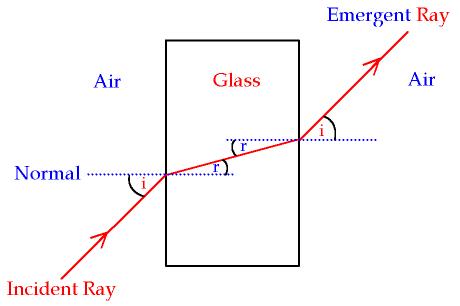
There was a mathematical relationship between the angle of incidence (angle between ray on the way in and the normal) and the angle of refraction (angle between the ray inside the block that has changed direction and the normal)
sin i was proportional to sin r as shown by the graphs you plotted.
sin i / sin r (the gradient of the graph you plotted) gave us an idea of how much perspex bent light. This is a property of the perspex known as its refractive index, n. Our answer was about 1.4. This means that light travels 1.4 times slower in perspex than it does in air. (air hardly slows down light at all - it has a refractive index of very slightly over 1)
The relationship between sin i and sin r is dependent on the refractive index of the materials involved. You need to be able to use the formula to do calculations.
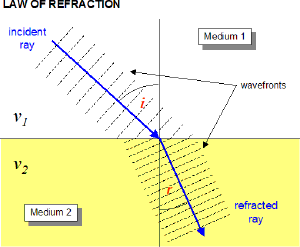
The more optically dense material reduces the wavelength of the light, slowing it down and changing its direction.
The second experiment was the semi circular glass block experiment shown below.
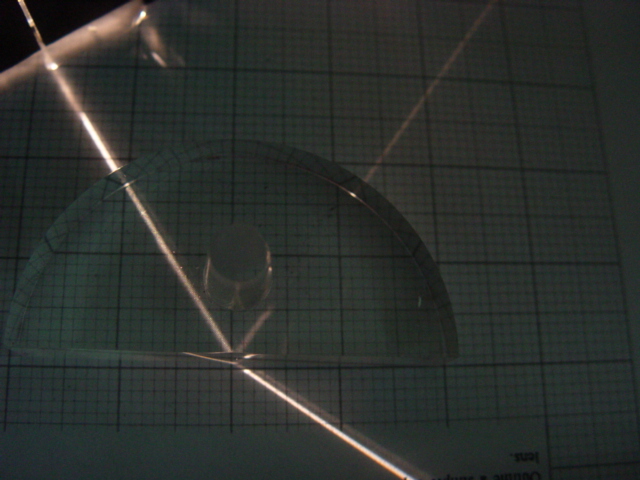
The ray doesn't bend on the way in, it is at 90 degrees to the glass surface. It turns away from the normal on the way out, as it speeds up. It obeys Snell's law in this case.
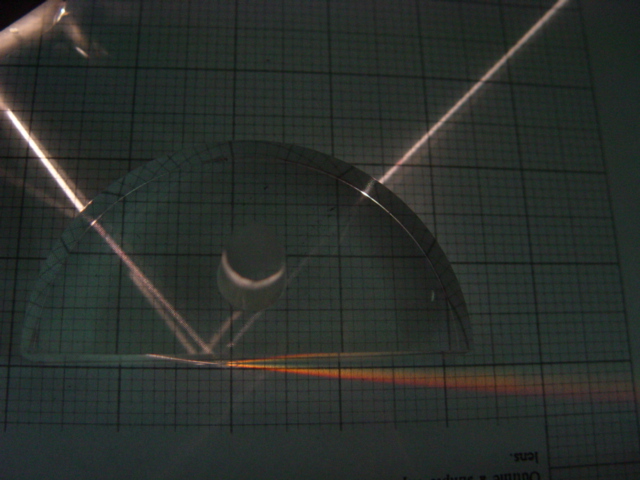
As the angle increases, the ray is refracted nearer to the glass surface and is split into a coloured spectrum and a weak reflected ray appears.

Above a certain angle, the critical angle (about 42 degrees for glass) all of the ray is reflected back. This is called total internal reflection
HW Complete the experimental worksheet for both experiments including plotting the sin graphs for both. If you didn't get results for the semicircular block, use these. i = 10, 20, 30, 40 r = 11, 25, 42, 65. The critical angle was 42 degrees or so so bigger angles than this totally internally reflected and didn't obey Snell's law.
We looked at calculations involving the simplified version of Snells law that you are required to know for IGCSE. This set of calculations was attempted.
We also looked at an adaptation of the equation for the specific case when light is shining out of a more optically dense material at its critical angle.
The critical angle is the angle of incidence at which total internal reflection first occurs.
This set of calculations was attempted.
We redid the 2 experiments on refraction that you probably did in the 3rd form. Both experiments showed Snell's law in action.
An experiment was carried out to see how much rays of light bent when they passed into a glass or perspex block. Rays were found to always bend towards the normal line (90 degrees from the glass surface) when they entered the block. This bending is called refraction. It happens because the light changes speed as it enters the perspex block.

There was a mathematical relationship between the angle of incidence (angle between ray on the way in and the normal) and the angle of refraction (angle between the ray inside the block that has changed direction and the normal)
sin i was proportional to sin r as shown by the graphs you plotted.
sin i / sin r (the gradient of the graph you plotted) gave us an idea of how much perspex bent light. This is a property of the perspex known as its refractive index, n. Our answer was about 1.4. This means that light travels 1.4 times slower in perspex than it does in air. (air hardly slows down light at all - it has a refractive index of very slightly over 1)
The relationship between sin i and sin r is dependent on the refractive index of the materials involved. You need to be able to use the formula to do calculations.

The more optically dense material reduces the wavelength of the light, slowing it down and changing its direction.
The second experiment was the semi circular glass block experiment shown below.

The ray doesn't bend on the way in, it is at 90 degrees to the glass surface. It turns away from the normal on the way out, as it speeds up. It obeys Snell's law in this case.

As the angle increases, the ray is refracted nearer to the glass surface and is split into a coloured spectrum and a weak reflected ray appears.

Above a certain angle, the critical angle (about 42 degrees for glass) all of the ray is reflected back. This is called total internal reflection
HW A 7 mark "exam question" asking you to detail the first experiment that you did to demonstrate Snell's law.
1st radioactivity test. We then reminded ourselves qualitatively about refraction.
Refraction: Waves change direction when they enter a medium which slows them down. The wavelength is reduced, not the frequency.


the waves bend back the other way when they exit the material which slows them down.
and total internal relection (TIR)

The ray doesn't bend on the way in, it is at 90 degrees to the glass surface. It turns away from the normal on the way out, as it speeds up. It obeys Snell's law in this case.

As the angle increases, the ray is refracted nearer to the glass surface and is split into a coloured spectrum and a weak reflected ray appears.

Above a certain angle, the critical angle (about 42 degrees for glass) all of the ray is reflected back. This is called total internal reflection
HW GCSE Qs on refraction and TIR (11 marks worth)
2nd radioactivity test.
You messed up that test something chronic. There will be another one on Wednesday. You have a selection of revision questions to do now. Compulsory revision session tomorrow morning break for all people who got under 55% (according to me).
Anyhow, we started waves.
This was a large topic in the 3rd form, but it is necessary for you to kmow a bit more this time around.
Waves transport energy from one place to another with no overall movement of matter. The energy is transported as vibrations (a combination of KE and PE) through some medium.
Waves come in 2 major types, transverse and longitudunal.
In transverse waves, vibrations occur which are perpendicular to the direction in which the wave is travelling. e.g. water waves, light.
Longitudunal waves have vibrations which are parallel to the direction of wave travel.
This site has excellent animations of the various types of waves.

transverse above

and longitudinal
Important quantities that you need to remind yourself of are:
1. Amplitude - the maximum "height" of the vibration. Easy to see in a transverse wave, not so easy in a longitudunal.
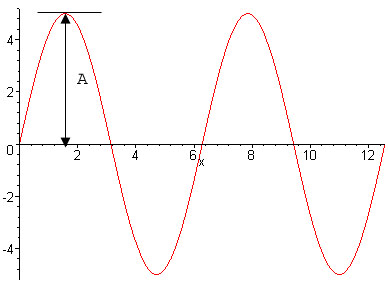
2. Wavelength - The distance from the peak of one wave, to the peak of the next. It can really be measured from any point on the wave, to the next equivalent point.

3. Frequency - the number of waves which happen per second (measured in Hz)
Related to the frequency is the Period (T) which is the time taken for one wave to happen.
The 3 main properties of waves, reflection, refraction and diffraction.
Here is the website with the cracking animations giving examples of all of these effects
Reflection: Waves reflect off plane surfaces at an angle which is equal to their angle of incidence.
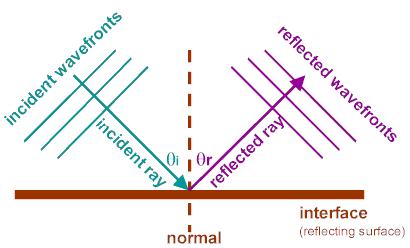
Refraction: Waves change direction when they enter a medium which slows them down. The wavelength is reduced, not the frequency.


We missed refraction out, we'll concentrate on it later.
Diffraction: Waves spread out when passing through a gap. The smaller the gap, the more spread out the waves become. If the gap is much larger than the wavelength, then diffraction less unnoticeable.
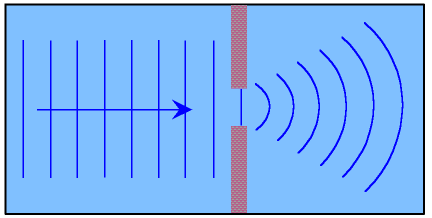
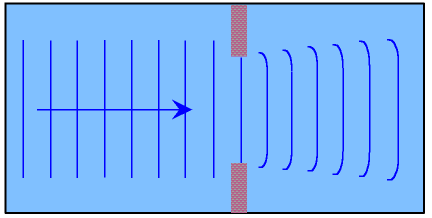
HW Revise (again) for radioactivity test. Turn up to the revision session.
Radioactivity test as promised.
We started to recap waves. This was a large topic in the 3rd form, but it is necessary for you to kmow a bit more this time around.
Waves transport energy from one place to another with no overall movement of matter. The energy is transported as vibrations (a combination of KE and PE) through some medium.
Waves come in 2 major types, transverse and longitudunal.
In transverse waves, vibrations occur which are perpendicular to the direction in which the wave is travelling. e.g. water waves, light.
Longitudunal waves have vibrations which are parallel to the direction of wave travel.
This site has excellent animations of the various types of waves.

transverse above

and longitudinal
Important quantities that you need to remind yourself of are:
1. Amplitude - the maximum "height" of the vibration. Easy to see in a transverse wave, not so easy in a longitudunal.

2. Wavelength - The distance from the peak of one wave, to the peak of the next. It can really be measured from any point on the wave, to the next equivalent point.

3. Frequency - the number of waves which happen per second (measured in Hz)
Related to the frequency is the Period (T) which is the time taken for one wave to happen.
The 3 main properties of waves, reflection, refraction and diffraction.
Here is the website with the cracking animations giving examples of all of these effects
Reflection: Waves reflect off plane surfaces at an angle which is equal to their angle of incidence.

Refraction: Waves change direction when they enter a medium which slows them down. The wavelength is reduced, not the frequency.


We missed refraction out, we'll concentrate on it later.
Diffraction: Waves spread out when passing through a gap. The smaller the gap, the more spread out the waves become. If the gap is much larger than the wavelength, then diffraction less unnoticeable.


HW Radioactivity revision for a test. Mr Phillipson informs me that you may have an English mock on Friday - so perhaps it will be this time next Wed.